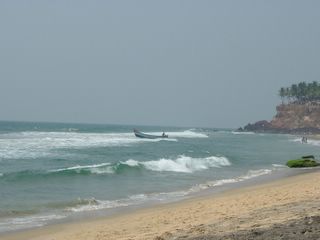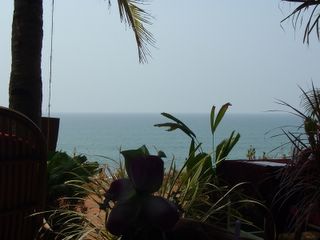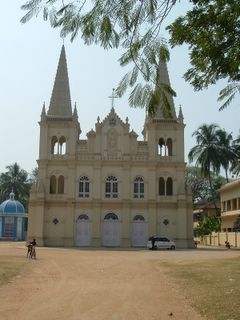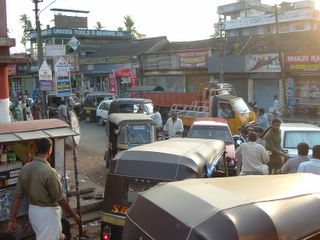From Kozhikode we (Jessie and another student Dan, and I) took a bus to a port city that had some good reviews in the India guidebooks. We hoped to meet up with another student and her husband there, but we never managed to cross paths. We took a general bus there… the windows were open, and it was HOT. In all that time in the conference, we hadn’t really had any interaction with Keralan culture. I mostly looked out the window at the scenery, which consisted of, of course, palm trees, and various shops along the way. The road was windy and the bus had to make many short stops to let people on and off. I was beginning to wonder whether the bus would ever make a bathroom break, when apparently my prayers were answered – the bus got a flat tire. Everyone piled out onto the road, and me and Jessie and Dan tried to guess what was actually going on (we didn’t know it was a flat tire at that point). Fortunately for me the tea shop in front of which we were stopped let me use their bathroom (this means the owner let me go use his house’s chaarpi, which was in the back). This provided a certain amount of relief, but we still weren’t sure how to get to our destination. Another bus pulled up, and we followed the herd on.
At that point, Jessie was carrying an extremely heavy suitcase full of donations of medicine for the tsunami victims. She had tried to arrange for it to be sent over to eastern south India, but the lady who had said she would facilitate this didn’t come through. So the suitcase had to come with us. We arrived in Ernakulum and finally to a hotel… The next day Jessie and I went shopping in the city, which was fun and a change of pace, and allowed me to buy some t-shirts and long skirts that were more weather appropriate than the clothes I had brought. Not that any clothing is appropriate in that heat. Anyone who ever questioned the dhoti (wrap that men wear), I am telling you now: it is the only logical piece of clothing to wear there. I don’t understand how women wear saris, either, but they do.
From Ernakulum we went to Fort Kochi, a historical port town and also tourist hot spot. In the morning we had gone to the nearest government hospital to drop off the medicines: Even though Kerala was not really ‘hit’ by the tsunami, we didn’t really have any options for what to do with the suitcase. In Fort Kochi, the vendors and rickshaw drivers heckled as though you didn’t have a choice whether you were going to pay or not. Hello, Madam? (Survey: Do I look like a Madam to any of you?) This was a new experience for me, as I had been somewhat heckled here in Nepal, but never this sort of full-out attack. Jessie berated me for politely explaining that I didn’t need a ride or want anything.
We toured Fort Kochi by foot and saw the huge old Chinese fishing nets in the ocean, beautiful old churches, a fairly ancient graveyard, and a synagogue (see photos). The entire area reminded me a little of New Orleans, and I’m not quite sure why. They serve fresh coconuts, off of which they chop the top and hand the rest to you with a straw. Jessie and I stayed in a tiny room, which had cute Jesus pictures above the door and beds. These did not offer much protection from the mosquitos, however. I hadn’t noticed the mosquitos very much until we reached Fort Kochi, but the number of bites on each leg quickly topped twenty. Jessie was a fan of the mosquito coil, but I figure most of my bites happened when I was outside.
After a day in Kochi we decided to go somewhere where we could swim in the ocean; we read that Varkala Beach was a good option, so went back over to the Ernakulum bus station and had a horrific time getting on a bus. The bus-finding process took approximately 2 hours, though technically our bus was arriving every 20 minutes. The bus station ‘office’ people couldn’t understand how we were missing our bus every time – perhaps its because the name of the place we are going is written in Malayalam (the local language), it pulls up for approximately 30 seconds while people push and shove their way to not even get a seat, the bus guy whose job it is to announce bus arrivals on the intercom (in Malayalam) has yet to point to our bus when it arrives like he assured us three times that he would, and we have no clue how to interpret the system they seem to find so simple. It made me miss Nepal a lot, since people will in general go out of their way to help someone (foreign or Nepali) find their way if they are lost.
Reading over this, I’m sure you are all thinking, “Why is she calling this a vacation? It sounds horrible.” It sounds horrible because I really am using this as a place to register my complaints, since heaven knows India did not have a box for that. Also, we were extreme budget travelers, and this means volunteering to be subjected to various levels of inefficiency and frustration. There was a lot of nice scenery and good food, like perotta (paratha) which is sort of like naan, made in a tandoori oven like naan, but even better. I am actually addicted to paratha because of this trip. At any rate I just want to point out that the reason I was so frustrated was because I didn’t understand how the system works and thus hoped it would by default revolve around us. If they would just take my advice and become efficient, everything would have been easy (riiiight).
Anyways, about half-way to Varkala beach, our bus tire went flat (YES, time number 2) and as it was getting dark we had no other recourse but to find the nearest hotel. Which was charming in its own way, as our hotel staff guy brought our food to our room, and when I asked for salt he went and got some and rather than handing it to me, sprinkled it on my food for me. Jessie called him our ‘brother.’ He didn’t know any different (better) than to just open our door and walk in to ask if we needed something or to take the plates away. It’s not really a knocking culture, just like Nepal, and I doubt they ever get tourist guests. I kind of felt like telling the guy that for foreigners it’s really important to knock, but I knew he’d think we were offended (we weren’t, we just locked our door after dinner).
This seems like as good a time as any to explain “special tea.” Kerala is a dry state, meaning that they aren’t allowed by the government to serve alcohol (unless they have a really expensive liquor license?). So in order for Jessie to order a beer (if you know me, you know that in my world –wonderland? oompa loompa land?- beer not only all tastes the same, but also is gross) she had to ask for “special tea,” which depending on the location means they will bring you a liter of beer in a bottle, OR they will bring it in a teapot complete with matching teapot. I’m not sure how they get away with this system, but maybe they just want a nominally dry Kerala to satisfy the religious voters.













